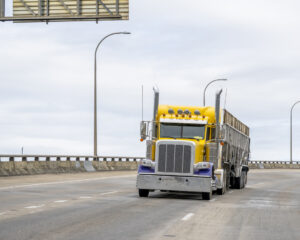It is said that recessions — including freight recessions — are often characterized by the letter shape they form when drawn on a graph.
For example, “V-shaped” recessions decline sharply and then recover quickly. “U-shaped” recessions decline and then remain at the bottom for a bit before recovering. “W-shaped” recessions dive to the bottom, recover a little and then dive again before making a final recovery. There’s even a “K-shaped” recession, where some parts of the economy are rising at the same time other areas are falling.
However, there doesn’t seem to be a letter to describe the current freight recession. For months, analysts have claimed we’re at the bottom and should soon start climbing out of the doldrums.
Well, we’re still not climbing.
The Cass Freight Index for Shipments, published by Cass Information Systems, for October indicates that shipment numbers reported by its clients fell 4.7% in October from September levels. It’s not unusual for shipment numbers to fall in October, since September is the final month of the year’s third quarter, and shipments usually fall off in the following month. But even when the totals are seasonally adjusted to account for the usual decline, the result this time still shows a 2.8% drop in shipment numbers.
The October shipment numbers are 9.5% lower than they were a year ago, in October 2022. If that’s not concerning enough, expenditures fell even further — the Cass Freight Index for Expenditures declined by 23.3% from October 2022.
Cass numbers are derived from the 36 million shipping invoices the processed for its customers each month. While the numbers include shipping by multiple modes of transportation — including truck, rail, pipeline, ship, barge and air — about three-quarters of the numbers come from trucking.
After all the economic growth achieved in recent years, the Cass Freight Index for shipments in October is very close to where it was eight years ago, in October 2015.
The Cass Freight Index for Expenditures shows that shipping expenditures in October fell 2.2% from September and 23% from October 2022. Those numbers are nearing the expenditure totals in October 2020, when the nation was in the throes of the COVID-19 pandemic. As rates climbed quickly in 2021, expenditures skyrocketed by 38%, and they rose another 23% in 2022, reaching record levels in mid-year.
They’ve been on the decline ever since.
According to Tim Denoyer, vice president and senior analyst for ACT Research, who writes for the Cass report, the pain won’t be ending any time soon.
“Our outlook is for freight markets to keep bouncing along the bottom in the near term, followed by some holiday volatility and a change in trajectory next year,” Denoyer wrote.
DAT Freight and Analytics reported that average per-mile spot rates for dry van loads averaged $1.525 (excluding fuel surcharge) in October, down about 23 cents from October 2022 averages. The rate was also down about four cents from September.
In the refrigerated segment, average spot rates were about $1.86 per mile in October, down about a nickel per mile from September and nearly 21 cents from October 2022. Flatbed spot rates averaged $1.835 per mile, down 1.5 cents from September rates and nearly 23 cents lower than October 2022.
A telling statistic reported by DAT is the load-to-truck ratio of postings on its load board. Of course, load board customers can accept loads without posting their trucks, so there won’t be a direct 1:1 ratio, but the numbers are still useful. When there are more loads per truck, rates rise. When loads decrease, there’s more competition for them and rates decline. For October, for example, there were 1.96 loads posted for every truck posted for dry van. October 2022 ended with 2.71 loads per truck and rates 23 cents per mile higher. A year earlier, in October 2021, there were 5.5 loads for every truck and rates were about 93 cents per mile higher.
Both refrigerated and flatbed numbers showed similar results, with both higher load-to-truck ratios and higher rates.
The question everyone is asking now is this: “When will it change?”
The answer is that change is already happening — but it’s excruciatingly slow. In an ACT Research release on October 30, Denoyer wrote, “We continue to expect the freight market cycle to turn once capacity tightens, but early signs of 2024 equipment production suggest that may be a while.”
He’s talking about trucks. There are simply too many trucks available to haul the amount of freight being offered. Too much supply for too little demand means rates will stay low until a correction occurs. Judging from the way new trucks are being ordered, built and delivered, the oversupply of trucks isn’t ending anytime soon.
“Even as the freight demand cycle should improve in 2024, the demand outlook remains soft for this winter as the industry continues to add equipment capacity into an oversupplied market,” Denoyer explained.
While new trucks continue to be sold, carriers are going out of business at record rates. Owner-operators and small fleet owners who bought trucks when spot rates were high, often at exorbitant prices due to demand, are now selling or surrendering those trucks because of low freight rates. Carrier authority surrenders have exceeded new carrier starts for more than six months.
Some of those surrendered trucks are helping drive down used truck prices. That’s good news for those looking to upgrade equipment; unfortunately, high interest rates may negate any price savings for buyers. Many owners who surrendered those trucks have gone back to company driver positions, so the total number of trucks available to haul freight hasn’t declined enough to impact the market.
The bottom line is that the bottom line of most carriers will continue to suffer for the near future.
Cliff Abbott is an experienced commercial vehicle driver and owner-operator who still holds a CDL in his home state of Alabama. In nearly 40 years in trucking, he’s been an instructor and trainer and has managed safety and recruiting operations for several carriers. Having never lost his love of the road, Cliff has written a book and hundreds of songs and has been writing for The Trucker for more than a decade.








